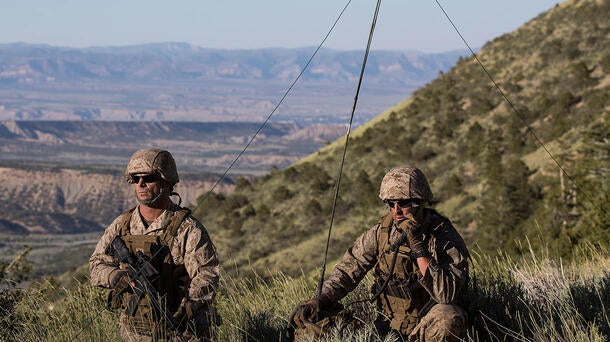As combat environments, including space, become more contested, military customers require easy-to-use robust, cost-effective Beyond-Line-Of-Sight communications in the absence of satellite availability.
U.S. Armed Forces have renewed interest in L3Harris Technologies’ high-frequency communications solutions, including the Falcon III® AN/PRC-160 Wideband HF/VHF Tactical Radio System. The U.S. Army announced last October that it had ordered more than 1,500 AN/PRC-160 HF radios. The U.S. Marine Corps followed suit that December and informed L3Harris of a $50 million follow-on delivery order for the radios as part of its High Frequency Radio II (HFR II) modernization program. And, in March 2020, the Marine Corps awarded L3Harris a five-year, $383 million ceiling, single-award Indefinite Delivery, Indefinite Quantity (IDIQ) contract — with an initial delivery order of $89 million — for Falcon III AN/PRC-160 HF radios as part of its High Frequency Radio II program.
“HFR II will fill much of the same needs that the legacy HFR system provided: long haul communications, and the primary backup mode of communications in a Satellite Communications-denied environment,” Leigh King, Marine Corps Systems Command’s project officer for the HFR II, said in a Marine Corps Systems Command press release.
As the global leader in tactical communications, L3Harris Technologies is on the cutting edge of advancements in HF communications. Through continuous innovation, our radios and related equipment deliver new and enhanced capabilities never before possible with legacy HF radios.
HISTORY, ADVANTAGES AND CHALLENGES
High-frequency radio communications have been an element of civil and military communications for decades. With the inherent ability to communicate at distances that span the globe, HF has provided an accessible and versatile tool for long-haul communications. During World War II, for example, HF communications were the primary means for ship-to-shore and ground-to-air communications. Adjusting HF and antenna orientation enables radio waves to either traverse the ground (ground or surface wave) or refract off the ionosphere (sky wave); this flexibility results in communications that can penetrate thick tree canopies, reach into valleys and provide reliable voice communications over long distances.
Effective HF communications have been seen as a skill to be mastered. An understanding of environmental conditions, antenna takeoff angle, signal amplification and frequency propagation are all elements to consider for successful communications over HF. When any one of these elements is miscalculated, communications will be unsuccessful — for instance, selecting a high-HF frequency with the wrong antenna takeoff angle could result in radio waves piercing the ionosphere and never refracting to desired receive radio. Though HF has been a powerful tool, it has taken mastery of communicators to harness the power.

Legacy HF systems were typically limited to relatively narrow bandwidth allocations. In the past, HF radios utilized bandwidth in the range of 3 kHz, which is sufficient for voice and low data rates but lacks the capacity for more robust and resilient data transmission. Today’s HF radios are vastly more capable of transmitting both voice and data, while additionally offering the resiliency needed by forces in contested environments.
THE CUTTING EDGE OF HF RADIOS
In 2012, L3Harris delivered the RF-7800H-MP Wideband HF/VHF Tactical Radio System, the first wideband HF manpack with bandwidths up to 24 kHz and data rates up to 120 Kbps. This radio was specifically designed to provide HF advantages for international partners.
As the next-generation HF radio system was being designed for delivery to the field, L3Harris purposefully took into consideration the 130 countries around the world where legacy HF systems were deployed. L3Harris designed a solution that could leverage the existing infrastructure and ease the technical and logistical burden of upgrading; installations could be left intact — all ancillaries, including antennas, antenna couplers, power amplifiers and cables, could be reused — and reap the benefits of a modernized HF system.

LEARN MORE ABOUT FALCON RADIOS>>
Additionally, L3Harris designed its wideband HF manpack with the intelligence to downgrade real-time to a narrowband STANAG 4538 system for legacy interoperability. These design choices showcase L3Harris’ commitment to innovation and commitment to making HF more powerful and easier for the warfighter to use.
In 2017, L3Harris announced the release of the AN/PRC-160, the first wideband HF manpack meeting new NSA crypto-modernization standards. Its software-defined architecture allows waveform and encryption updates, giving mission-critical information added layers of security and future extensibility. Consistent with the versatility and power of HF, L3Harris focused its internal development funding to pursue extremely robust and resilient waveforms to be used across the battlespace.
COMING NEXT
L3Harris has led major developments in tactical communications over many decades and continues to push the envelope by adding even more resilient waveforms and last-ditch voice and data capabilities to the software-defined architecture. While HF may represent one of the oldest means of long-distance voice communications, make no mistake, HF is in high demand and offers enduring value to the warfighter.
